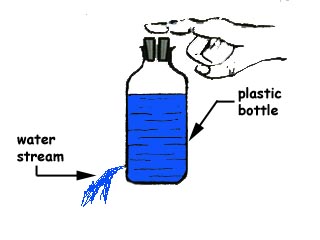|
Materials:
| · |
an
empty plastic bottle |
| · |
a
one-hole stopper fitting the neck of the bottle (screw-on lid
or cap with small hole) |
|
|
Procedure:
| 1. |
Punch
a hole in the side near the bottom of the bottle with a small
nail. |
| 2. |
Fill
the bottle with water and show the leaking container to your
parent. |
| 3. |
Ask:
"How can I stop the leak without wetting my finger?" |
| 4. |
Put the
one-hole stopper on the bottle and cover the hole with one finger:
the leak is stopped! |
| 5. |
Release
your finger from the stopper: the leak will start again. |
|
| Explanation: |
| |
The water does not
stop flowing immediately after covering the stopper, but it still
keeps dripping out of the bottle for awhile. This increases the
volume of the air pocket above the water. The amount of air stays
the same because air is prevented from coming into the hole in
the stopper. The increase in volume causes a decrease in pressure
(Boyle's Low). The outside atmospheric are pressure pushes against
the water and prevents it from flowing out.
This is why we always punch two holes in a can of evaporated
milk to pour the milk out. In large gasoline containers you may
have noticed the small sealable vent opposite the pour spout.
This hole will allow air to enter the can as the gasoline is
poured out. It will promote a smooth flowing of oil out of the
can. |
Follow-up:
| 1. |
Why
did the water stop flowing out of the bottle? |
| 2. |
How
could you stop the leak of the the lid with the hole was missing? |
| 3. |
Does
the water stop flowing immediately after the hole is covered?? |
| 4. |
How
does the air pressure inside the can compare with the atmospheric
pressure air pressure after the water stops flowing?? |
| 5. |
What
is it that we prevent from entering the can by covering the hole?? |
| 6. |
What
purpose is served by the small vent in a gasoline? |
|
|
Obtaining credit for your
efforts
- Print a copy of the blank laboratory write-up
paper.
- Read and complete each section, incomplete
write-ups receive no credit.
- Have your parent check your work and sign
the paper.

|
|
